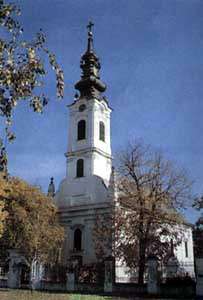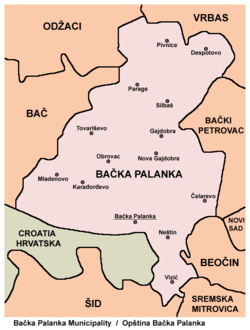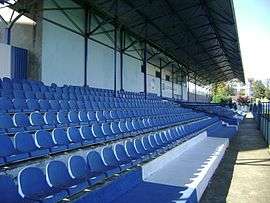Bačka Palanka
| Bačka Palanka Бачка Паланка | ||
|---|---|---|
| Municipality and Town | ||
|
View of Bačka Palanka centar. | ||
| ||
 Location of the municipality of Bačka Palanka within Serbia | ||
| Coordinates: 45°15′N 19°24′E / 45.250°N 19.400°ECoordinates: 45°15′N 19°24′E / 45.250°N 19.400°E | ||
| Country | Serbia | |
| Province | Vojvodina | |
| District | South Bačka | |
| Settlements | 14 | |
| Area[1] | ||
| • Municipality | 579 km2 (224 sq mi) | |
| Population (2011 census)[2] | ||
| • Town | 28,239 | |
| • Municipality | 55,528 | |
| Time zone | CET (UTC+1) | |
| • Summer (DST) | CEST (UTC+2) | |
| Postal code | 21400 | |
| Area code | +381 21 | |
| Car plates | BP | |
| Website |
www | |

Bačka Palanka (Cyrillic: Бачка Паланка, pronounced [bâːtʃkaː pǎlaːnka]) is a city and municipality located in Vojvodina province of Serbia, on the left bank of the Danube, at 45.15° North, 19.24° East. In 2011 the city had a total population of 28,239, while Bačka Palanka municipality had 55,528 inhabitants.
Name
In Serbian, the town is known as Бачка Паланка or Bačka Palanka, in Slovak as Báčska Palanka, in Croatian as Bačka Palanka, in Hungarian as Bácspalánka, in German as Plankenburg and in Turkish as Küçük Hisar.
Its name means "a town in Bačka" in Serbian. The word "palanka" itself originates from Turkish language and means "town". This word was also adopted by Serbs and it is used in the Serbian language with the same meaning. Older Serbian names for this town were Palanka (Паланка), Stara Palanka (Стара Паланка), Nova Palanka (Нова Паланка) and Nemačka Palanka (Немачка Паланка).
History
Archeologists have proved that people have lived in the area for centuries. There are many archaeological objects from the Stone Age, Bronze Age, Iron Age and Roman period.
In the 11th century, this area was populated by Hungarians and Serbs.[3] Bačka Palanka is first mentioned as a settlement in 1486, as a suburb of Ilok called Iločka. Until the 16th century, this area was administered by the Kingdom of Hungary.
At the beginning of the 16th century, the village was the property of landowner Laurence of Ilok, a duke of Syrmia. It was destroyed by the Ottomans after The Battle of Mohács in 1526, but was then rebuilt as small Ottoman fortress named Palanka. During the Ottoman administration (16th-17th century), Palanka was mostly populated by ethnic Serbs.[4]
In 1687 Palanka was included into the Habsburg Monarchy and more Orthodox Serbs settled here. Palanka was then mentioned as a small town with 167 houses, all of them Serb (1720 census data).[5] Later, Germans, Slovaks and Hungarians settled here as well.[3]
It was part of the Habsburg Military Frontier from 1702 to 1744. Nova Palanka (New Palanka) was founded between 1765 and 1770, 2 kilometers away from the original Palanka (which then became known as Stara Palanka - Old Palanka) and Nemačka Palanka (German Palanka) was founded by Danube Germans in 1783. Those three towns will become one city, Bačka Palanka, in the 20th century.
Palanka's industrial development started in 1765, when a brick plant was built. It got its first post office in 1828. In 1875, one of the first libraries in Vojvodina was opened. In 1884 the Sintelon company was founded. In 1886, the first public school started working. By the year of 1894, a railroad was built from Bačka Palanka to Feketić and a first phone call was made with Novi Sad.
In the second half of the 19th century, the German population became more numerous than the Serbian.[6] According to the 1910 census, the population of Stara Palanka was mostly Serb, while populations of Nova Palanka and Nemačka Palanka were mostly German.[7]
The city was under Habsburg administration until 1918, when it became part of the Kingdom of Serbs, Croats and Slovenes (later renamed as Yugoslavia). During the World War II (from 1941 to 1944), it was under Axis occupation. In 1944, one part of Bačka Palanka citizens of German ethnicity left from the city, together with the defeated German army. As a consequence of the war, the site of a post-World War II work camp for the remaining ethnic Germans (Donauschwaben) was formed here under new communist administration. After work camps were dissolved (in 1948), the remaining German population left Yugoslavia because of economic reasons. Instead of the Germans, 3,609 (mostly Serb) colonists settled in the town after World War II. Most of them originated from Bosnia and Herzegovina.
During the 1990s, about 5,000 refugees from Croatia and Bosnia moved to Bačka Palanka because of the Yugoslav wars. During the NATO bombing in 1999, Bačka Palanka was bombed by NATO only twice, on 2 and 27 April. Both times the target was the Ilok–Bačka Palanka Bridge. It was only damaged, but not destroyed.
In 2002, 4 tons of fish stew were cooked at Kaloš Čarda at the Bager Lake in Bačka Palanka and it entered Guinness Book of Records.
Inhabited places

Bačka Palanka municipality includes the city of Bačka Palanka and several villages.
Villages on the northern bank of the river Danube, in the region of Bačka:
- Gajdobra
- Despotovo
- Karađorđevo
- Mladenovo
- Nova Gajdobra
- Obrovac
- Parage
- Pivnice
- Silbaš
- Tovariševo
- Čelarevo
Villages on the southern bank of the river Danube, in the region of Syrmia:
Demographics
Ethnic composition of the town and municipality:
| Ethnic group | Population (town) |
Population (municipality) |
|---|---|---|
| Serbs | 23,155 | 43,843 |
| Slovaks | 1,055 | 5,047 |
| Hungarians | 1,003 | 1,356 |
| Roma | 262 | 1,064 |
| Croats | 520 | 819 |
| Yugoslavs | 117 | 160 |
| Montenegrins | 73 | 133 |
| Germans | 74 | 105 |
| Others | 1,980 | 3,001 |
| Total | 28,239 | 55,528 |
Historical population of the town:
- 1948: 12,830
- 1953: 13,625
- 1961: 16,475
- 1971: 21,104
- 1981: 25,001
- 1991: 26,780
- 2002: 29,449
- 2011: 28,239
Tourism
Tourism is developed in Bačka Palanka. The city is famous for Tikvara, a Natural Monument. Tikvara is a Danube lake. Tikvara covers an area of 5 square kilometres (1.9 square miles). The Tikvara Resort complex is built along the lake for practising various sports, recreational and entertaining activities. There are 33 archeological sites in the municipality. It is also known for Karađorđevo, which has a hunting ground and horse farm. People enjoy racing derbies in Karađorđevo. Bačka Palanka's Serbian Orthodox church St. John the Baptist is one of the oldest churches in Vojvodina. North of the town is the Bagremara forest.
Industry
Industry in Bačka Palanka started developing in the 18th century. The first companies were built in the second half of the 18th century. A brick plant was opened in 1765, and a tobacco storehouse was opened a year later. In 1974 the Bridge of Youth was built to connect Bačka Palanka and Ilok in Croatia. Today, Bačka Palanka falls among the ten most developed municipalities in Vojvodina. Bačka Palanka municipality is an agricultural and industrial center. The main industries are food, metallurgy, textiles, electronic and machine industry. The most famous factories are Enia, Sintelon, Tarkett, Nectar, Dunavprevoz, AD Bačka, Carlsberg, Marina, Majevica, Plattner, Žitoprodukt, Budućnost and others.
Sports
Sport is very popular in Bačka Palanka. People enjoy swimming in Lake Tikvara and cycling down the banks of The Danube. Sports include handball, football (soccer), basketball and karate. There is a chess tournament every year, Bačka Palanka Open.
The most famous sport clubs in Bačka Palanka are:
- FK Bačka, the most popular and most successful football (soccer) club in the municipality, and the second division club's longest trail in northern Serbia after the football club Spartak Subotica, Proleter Zrenjanin and Novi Sad.
- Stari Grad, football (soccer) club
- Krila Krajine, football (soccer) club
- Čsk Pivara, football (soccer) club in Čelarevo
- Sintelon, handball club
- Nopal, women's handball club
- Sintelon, kayak club
- Bačka Palanka, basketball club
Politics
List of town mayors
- Zvezdan Kisić (Socialist Party of Serbia), former
- Kosta Stakić (Democratic Party), former
- Dragan Bozalo (Serbian Radical Party dr Vojislav Šešelj), former
Municipal parliament
Seats in the municipality parliament won in the 2004 local elections:[8]
- Serbian Radical Party (16)
- Democratic Party (9)
- Socialist Party of Serbia (6)
- Democratic Party of Serbia (4)
- Strength of Serbia Movement (3)
- Serbian Renewal Movement (2)
- Group of citizens "Club of Pivnice citizens" (2)
Seats in the municipality parliament after 2008 elections:[9]
- SRS (18)
- DS (13)
- SPS (4)
- DSS (4)
- G17 (3)
- PSS
- SNP
Famous people
- Alex Andjelic, ice hockey player and coach.
- Antal Benda (1910-1997), a Hungarian field handball player who competed in the 1936 Summer Olympics. Born in Bačka Palanka.
- Franz Eisenhut (1857-1903), a Danube Swabian Orientalist and Realist painter. Born in Bačka Palanka.
- Milan Janić (1957–2003), a Yugoslav kayak champion and a member of the national team. Born in Bačka Palanka.
- Natasa Janics (Nataša Janić), a Hungarian canoer with a Serbian background. Born in 1982 in Bačka Palanka.
- Zvezdan Jovanović, also known as Zveki and Zmija (Viper) assassinated former Serbian Prime Minister Zoran Đinđić on 12 March 2003.
- Mihalj Kertes, director of Federal Customs Bureau of Federal Republic of Yugoslavia, a close associate and man of trust of Slobodan Milošević.
- Kalman Konrad (1896–1980), one of the best football players in the Kingdom of Hungary in the 1910s. Born in Bačka Palanka.
- Nikola Krstić, that earned the title of honorary citizen of this town, even though he originated from Belgrade.
- Milan Kurepa (1933–2000), a renowned Serbian atomic physicist. Born in Bačka Palanka.
- Milan Mačvan, Serbian professional basketball player.
- Aleksandar Petrović (Aca Seltik), singer of the band "Orthodox Celts" from Belgrade.
- Đorđe Stojaković, Serbian revolutionary, active in the Revolutions of 1848.
- Dragan Sudžum, handball player.
- Žarko Šešum, handball player.
- Marko Vujin, handball player.
- Dragan Zorić, a Serbian flatwater canoer and current (2006) world champion. Born in 1979 in Bačka Palanka.
International relations
Twin towns - Sister cities
Bačka Palanka is twinned with:
See also
References
- Bibliography
- Slobodan Ćurčić, Broj stanovnika Vojvodine, Novi Sad, 1996.
- Notes
- ↑ "Municipalities of Serbia, 2006". Statistical Office of Serbia. Retrieved 2010-11-28.
- ↑ "2011 Census of Population, Households and Dwellings in the Republic of Serbia: Comparative Overview of the Number of Population in 1948, 1953, 1961, 1971, 1981, 1991, 2002 and 2011, Data by settlements" (PDF). Statistical Office of Republic Of Serbia, Belgrade. 2014. ISBN 978-86-6161-109-4. Retrieved 2014-06-27.
- 1 2 "Историја". Backapalanka.rs. Retrieved 2011-09-15.
- ↑ Dr Dušan J. Popović, Srbi u Vojvodini, knjiga 1, Novi Sad, 1990, page 113.
- ↑ Ivan Jakšić, iz popisa stanovništva Ugarske početkom XVIII veka, Novi Sad, 1966, pages 300-303.
- ↑ Dr Slobodan Ćurčić, Naselja Bačke - geografske karakteristike, Novi Sad, 2007, page 182.
- ↑ http://img190.imageshack.us/img190/3899/vojvodina1910.png
- ↑ Archived 29 September 2007 at the Wayback Machine
- ↑ "Dragan Bozalo ponovo predsednik Opštine Bačka Palanka - RADIO-TELEVIZIJA VOJVODINE". Rtv.rs. Retrieved 2011-09-15.
External links
| Wikimedia Commons has media related to Bačka Palanka. |
- Bačka Palanka Online
- Business directory of Bačka Palanka (Serbian)
- Danube-town Fun-Forum of the city Bačka Palanka
- Tourist organization of the municipality Bačka Palanka
- Sports and Recreation Center and Nature Park Bačka Palanka
| ||||||||||||||||||||||||||||||||||||||||||||||||||||||||||||||
| |||||||||||||||||||||||||





